This article comes fromNansen, Odaily translator | Moni
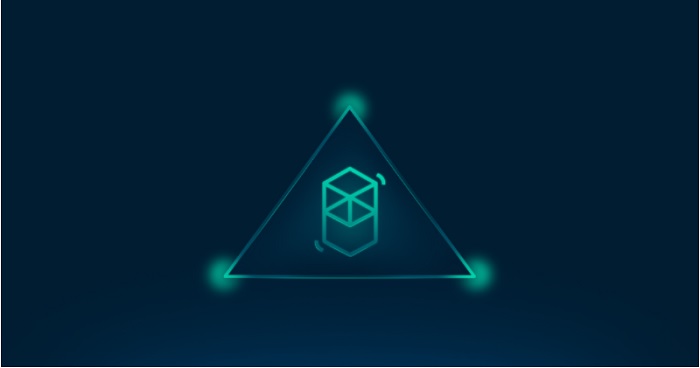
introduce
, Odaily translator | Moni
secondary title
introduce
secondary title
What is Fantom?
Fantom is a highly scalable blockchain platform for DeFi, crypto dApps, and enterprise solutions that aims to break through the limitations set by "old school" blockchains by using the Lachesis protocol, a custom asynchronous Byzantine Fault-tolerant (aBFT) consensus mechanism, Fantom’s on-chain processing is faster, safer, and more scalable than those blockchains built on previous consensus algorithms.
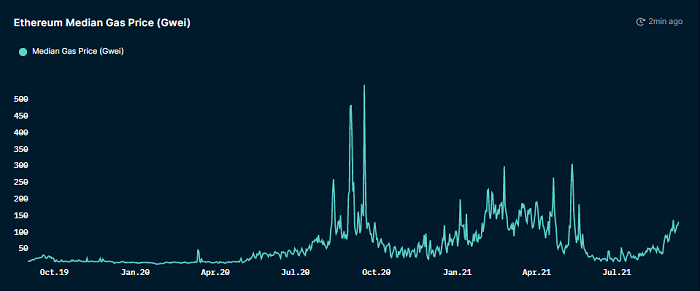
In order to follow the multi-chain trend in the future, Fantom has bridged various chains into its network, such as Ethereum, BSC, Polygon, and Avalanche. At present, major Ethereum projects such as SushiSwap and Curve have been migrated to Fantom, and traffic has also been introduced along the way. On the other hand, SpookySwap--the first native yield farming and AMM DEX on the Fantom chain-has gained a lot of popularity, ranking second only to AnySwap and ahead of Curve and Beefy Finance in the lockup rankings.
secondary title
Transaction and Gas Fees
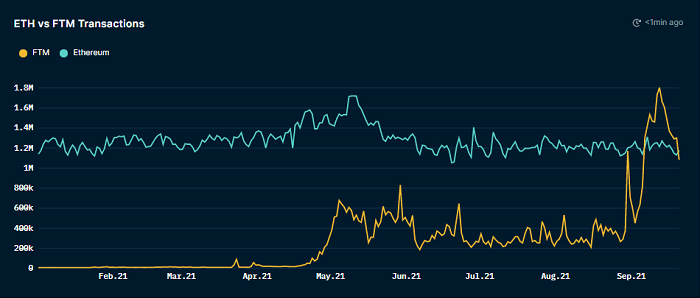
Since the rise of DeFi in the summer of 2020, we have witnessed huge fluctuations in Gas fees on Ethereum due to network congestion. The ever-increasing network demand has forced users to bear excessively expensive transaction fees, and it has been unable to motivate developers to participate in construction. From the figure below, we can see that in the past 2 years, the median gas cost of Ethereum has risen sharply, so it is urgent to expand the network and develop a solution compatible with Ethereum.
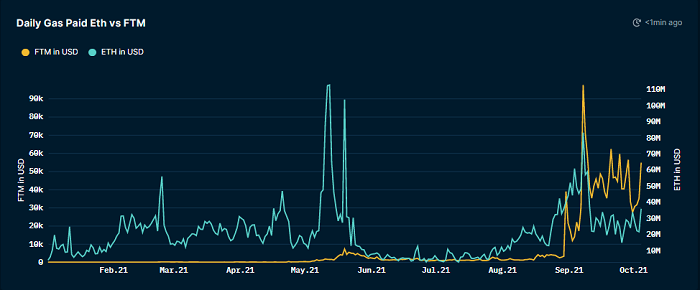
While each network on Fantom is built independently and independently at different scales, they all have one common function: to improve performance and reduce congestion. In addition, the Fantom mainnet uses the Ethereum Virtual Machine (EVM), which is compatible with Ethereum. This compatibility enables developers to migrate quickly and experience higher performance and lower costs.
As shown in the chart below, just after Fantom announced the launch of a $370 million liquidity mining incentive plan in late August 2021, the number of transactions on Fantom surpassed that of Ethereum in September. At the same time, we found that the average daily gas fee on Fantom is much lower than that on the Ethereum network. The reason for this is that Fantom itself is built based on lower transaction costs.
Above: ETH volume vs. FTM volume
Above: Eth daily average gas cost vs. FTM daily average gas cost
secondary title
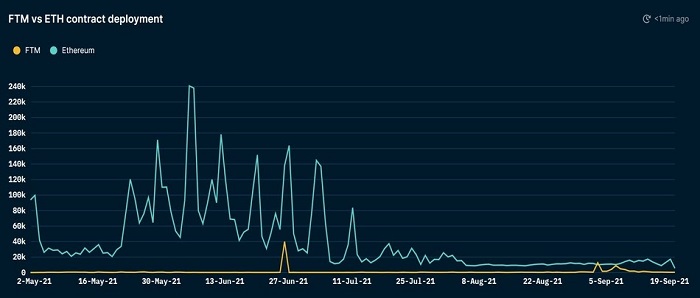
Contract Deployment Event
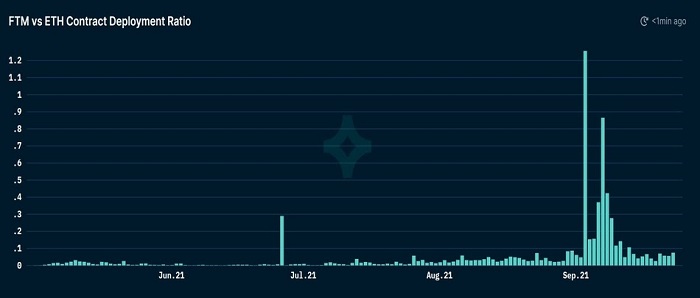
This phenomenon is more clearly shown in the figure below, which shows the number of contract deployments on Ethereum and Fantom. We saw that in early June, the number of Ethereum contract deployments reached its peak, and more than 240,000 contracts were deployed in one day. But after that, contract deployment activity started to decline and stabilized below 20,000 copies per day. On the other hand, after Fantom announced its liquidity mining incentive plan, its contract deployment activity surged in early September 2021, with a peak of about 12,800 contracts deployed per day. It is worth noting that during this period, the contract deployment activity of Fantom was higher than that of Ethereum.
Smart Money
Above: Contract deployment activity FTM vs ETHhereAbove: Contract Deployment Rate FTM vs ETH
secondary title
If you are familiar with Nansen, then our Smart Money wallet analysis tab should be familiar. Smart Money is an indicator label of Nansen's data analysis service. Other indicator labels include Smart LP, Flash Boys, Whales, Funds, etc.
here
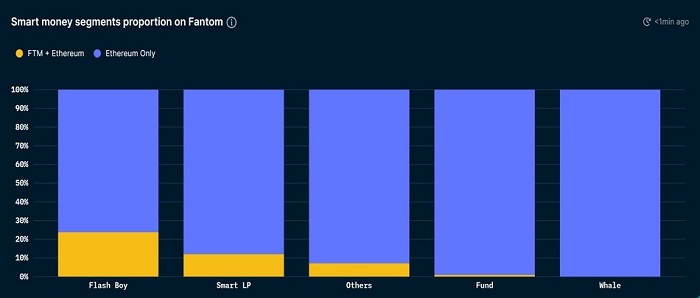
You can view the definition of the relevant wallet tag.

If we compare these numbers with those on Binance Smart Chain, the Smart Money overlap on Fantom is much lower, perhaps suggesting that Fantom is still in the early stages of Smart Money adoption.
stable currency
Above: Distribution of Smart Money on FTM & ETH
Above: Smart Money coincidence rate of different indicator labels
secondary title
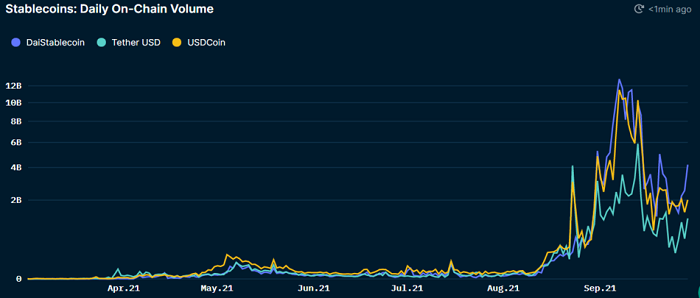
stable currency

On the Ethereum network, Tether (USDT) is currently the stablecoin with the highest market value and dominates the circulation of stablecoins with a huge market advantage. In terms of transaction volume, USDT’s transaction volume is almost twice that of USDC and DAI combined. However, on the Fantom network, the dominant stablecoins are USDC and DAI, and USDT ranks third, which shows that there is no dominant stablecoin market leader on Fantom, so pay attention to future stablecoins in Fantom It's going to be fun to perform.
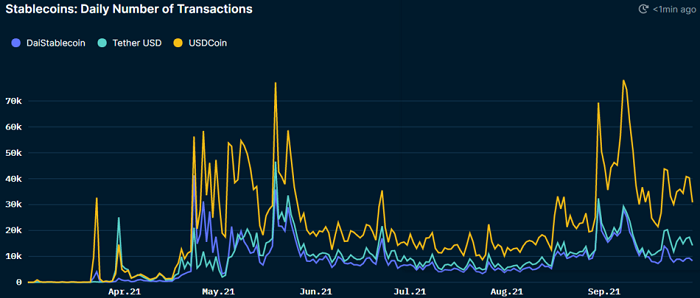
The surge in stablecoin activity on the Fantom blockchain suggests that its usage is gradually increasing, especially after Fantom announced its liquidity mining incentive program in September, resulting in an explosion in stablecoin activity during the month. The increase in the number of stablecoins is a positive indicator, as it means that there is ample liquidity on the Fantom chain, allowing users to employ more complex strategies than on the Ethereum mainnet, at a lower cost and significantly faster. However, stablecoin activity on Fantom also did not escape a decline during late September, when the overall cryptocurrency market was in decline.
Above: Fantom’s daily average on-chain stablecoin transaction volume
Above: Number of daily active transaction senders for Fantom stablecoins
Above: Fantom stablecoin daily transaction volume
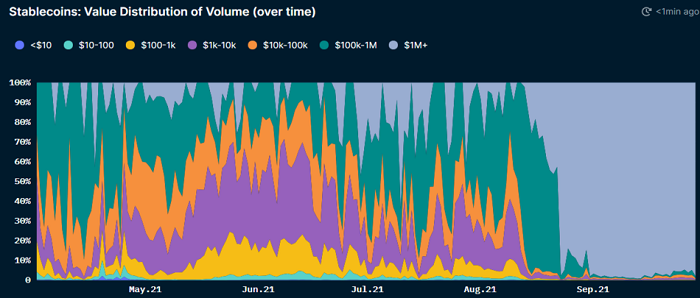
The average value of stablecoin transactions is a good indicator for evaluating the capital/wallet size of Fantom users. In Nansen's stablecoin background, it can be seen that the value distribution of transaction size over time presents an interesting picture (as follows shown in the figure).
in conclusion
In September, the volume of stablecoins on Fantom was very high. Interestingly, the percentage of large transactions over $100,000 has been on the rise. Additionally, transactions over $1 million consistently account for more than 90% of all transaction volume on the blockchain. This may be due to the gradual influx of funds, incentivized by the liquidity mining program.
Above: Distribution of stablecoin volume and value over time on Fantom